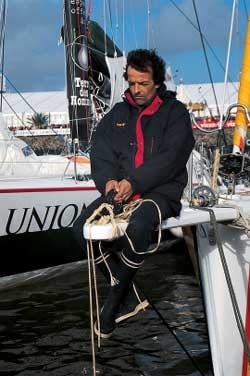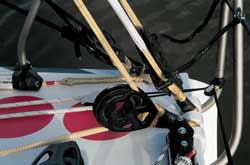
C08MCGEARY01.jpg
Many of the arts of the seaman are rooted in tradition, and when new materials replace those that have been around for a while, the rules for using them can be quite different from the time-honored conventions. When stainless-steel shackles came along, for instance, we learned to seize the pins with wire once wed tightened them because, unlike rough-finished galvanized steel, stainless-steel tends to unthread when subjected to vibration.
Similarly, were gradually learning ways to make the best use of such “high-tenacity” (high-strength) synthetic fibers that are used in modern cordage. Discussed in “Getting a Line on Cordage” (July 2002), these include the ultra-high-molecular-weight polyethylene or UHMPE fibers used in Spectra and Dyneema; the para-aramid fibers used in Kevlar, Twaron, and Technora; the polyester-polyarylate found in Vectran; and PBO, which stands for poly-paraphenylene-2 6-benzobisoxazole and is used in Zylon.
Rope clutches: Clutches hold rope by friction. Their operating mechanisms may vary slightly, but they grip rope essentially in the same way a hand does, only with more force. However, they only grip the outside of the rope. This is fine when they’re used on single-braid lines because they’re gripping the whole rope. Problems can arise with double-braids, especially if the cover and core have different stretch and friction characteristics.
An extreme example of this dichotomy is a halyard made of line that has a PBO core wrapped with a protective polyester cover. Under load, the core will slip through the clutch inside the cover, so the cover has to be sewn to the core in the area in which the clutch is likely to hold it.
Spectra or Dyneema braided-core halyards often are stripped of their covers over the length that isnt handled, and the stripped part functions well in a clutch of appropriate size because its effectively now a single-braid and the UHMPE fiber is highly resistant to wear. The cruiser, perhaps less concerned with saving weight aloft than with protecting the halyard from sunlight, might leave the covers on Spectra-cored halyards of New England Ropes Spect-Set II, for example. However, stitching the covers to the cores at the clutch points would be a good precaution against slip and wear.
Knots: Avoid using knots to terminate high-modulus lines. Any knot or bend that comes under load lowers the breaking strength of any line in which it’s tied. In high-tech lines, the reduction can be dramatic. Knots can also slip out of slippery Spectra. All manufacturers and riggers recommend splicing–say, to halyard shackles or sail clews–as being far more reliable. The type of splice used depends on the lay of the line. Most rope manufacturers offer splicing kits and manuals, and the winter-bound sailor might consider periodically practicing with them. Otherwise, it’s best to have splices professionally made.
Cutting and finishing: Use any blade, including your beloved rigging knife, for nylon and polyester. For high-techs, especially the aramids, use a cheap knife–kitchen, fishing, or Ginsu–and sharpen it when you need to, which will be often. Don’t ruin the blade of a good knife by using it to cut such abrasion-resistant cordage.
Simply burning synthetic line is a lubberly way to finish the ends, and it just plain wont work with nonmelting aramids. Use a sailmakers whipping. Some riggers will cut a core short, whip it where its buried, then melt the polyester cover together to enclose it, which is seamanlike.
Coiling: Three-strand rope has a unidirectional lay, usually right-handed, so it has to be coiled in one direction, the direction of the lay. Braided rope is balanced, and it’s effectively made up of both right- and left-handed lays. Coil it, therefore, in figure eights to prevent it from hockling or kinking. Unwind lines from winches; don’t just lift the tail and let the turns spin up and off, or you’ll get hockles. To remove hockles, trail the line behind the boat. The worst thing you can do with braided line, whether sheet tails, halyard tails, or mooring lines, is wind it up into circular mats or Flemish coils.
Sheaves: The diameter of a sheave should be at least eight times that of the line. For a line with Kevlar or Twaron in its makeup, 10 times the diameter is better. Because rope flattens as it passes over a sheave, the groove in a sheave should be at least 10-percent wider than the line’s diameter. When replacing a wire halyard with rope, change the wire sheave for a rope sheave of the appropriate size.
Lashings: At one time, practically every rigging connection on a sailing vessel was a lashing. Advances in metalworking technology led to lashings being replaced by castings, forgings, and weldments, with shackles joining them together. Today, however, there’s a reverse trend. Modern synthetic fibers have woven a new life for lashings, and leading-edge rigging specialists–like Phil Garland of Hall Spars & Rigging in Bristol, Rhode Island–are showing the way.
|
|
| |
|

|
| |
| © Jeremy McGeary|
| |
|
|
| |
| The tail of a running backstay has been lashed to the stainless-steel rod of a new-age laminate chainplate to eliminate a metal-to-metal connection.* * *|
| |
|
|
|
“It makes sense,” Garland says, “to use lashed, tied, or spliced attachments to eliminate metal-to-metal contact and, thus, prevent wear of gear and hardware and to provide good alignment.”
The French rigging group Chien Noir, which has been applying the technique to Vendée Globe boats and other advanced designs for several years, uses a lot of Vectran. Garland prefers Spectra or Dyneema in this application for greater resistance to UV damage and general abuse, which is perhaps more of an issue on cruising boats than on racers, whose riggings get reworked every few months.
Among the benefits of the lashing technique is the elimination of noisy, clanking shackles. Another is that the spares cabinet carries a couple of different sizes of Spectra strands or cords instead of a large assortment of heavy, expensive metal hardware.
A lashing made with low-stretch Spectra is more difficult to effect safely than one crafted with nylon rope. Strands need to be laid with even tension. In nylon or polyester, tighter strands stretch until looser ones come under load and share the stress, which isnt the case with no-stretch exotics. The technique employed by the Chien Noir group is to pass several loops between the parts to be lashed, massage them to get them evenly tensioned, then bind them tightly together.
Its not an accident that Chien Noir was among the first riggers to marry traditional techniques to the most up-to-date materials. For many years, this rigging gang has been involved in the long-running French revival of historic sailing craft, and its work can be seen on many restored and replica vessels, including the 130-foot topsail schooner La Recouvrance, flagship of the city of Brest.
Such interaction reminds us that when it comes to sailing, we get the best out of whats new by drawing from the best of whats old.
Jeremy McGeary is a Cruising World associate editor.








